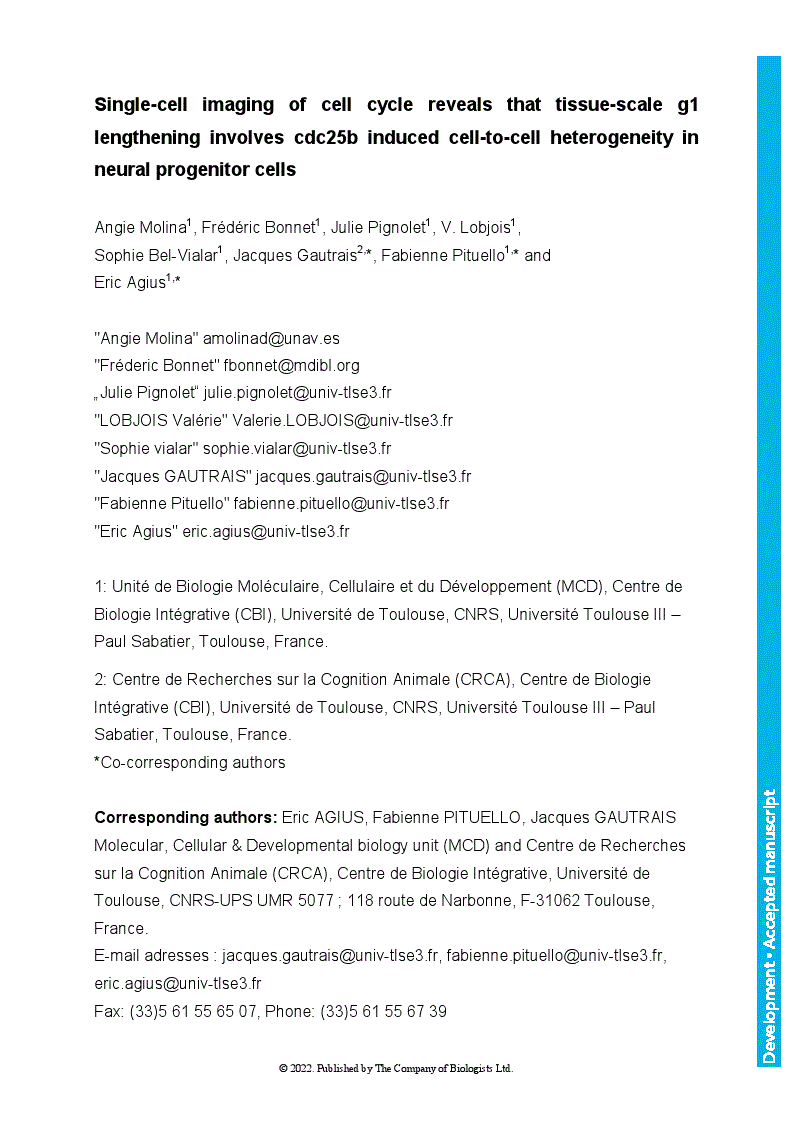While lengthening of the cell cycle and G1 phase is a generic feature of tissue maturation during development, the underlying mechanism remains still poorly understood. Here we develop a time lapse imaging strategy to measure the four cell cycle phases in single neural progenitor cells in their endogenous environment. We show that neural progenitors are widely heterogeneous regarding the cell cycle length. This duration variability is distributed over all phases of the cell cycle, with the G1 phase being the one contributing the most. Within one cell cycle, each phase duration appears stochastic and independent except for a correlation between S and M phase duration. Lineage analysis indicates that the majority of daughter cells may have longer G1 phase than mother cells suggesting that at each cell cycle a mechanism lengthens the G1 phase. We identify that the CDC25B phosphatase known to regulate G2/M transition, indirectly increases the duration of the G1 phase partly through delaying restriction point crossing. We propose that CDC25B increases G1 phase range of heterogeneity revealing a novel mechanism of G1 lengthening associated with tissue development.
Single-cell imaging of cell cycle reveals that tissue-scale g1 lengthening involves cdc25b induced cell-to-cell heterogeneity in neural progenitor cells
- Award Group:
- Funder(s): Centre National de la Recherche Scientifique
- Funder(s):
- Award Group:
- Funder(s): Ministre de L'Enseignement Superieur et de la Recherche
- Funder(s):
- Award Group:
- Funder(s): Agence Nationale de la Recherche
- Award Id(s): ANR-19-CE16-0006-01
- Funder(s):
Currently Viewing Accepted Manuscript - Newer Version Available
Angie Molina, Frédéric Bonnet, Julie Pignolet, V. Lobjois, Sophie Bel-Vialar, Jacques Gautrais, Fabienne Pituello, Eric Agius; Single-cell imaging of cell cycle reveals that tissue-scale g1 lengthening involves cdc25b induced cell-to-cell heterogeneity in neural progenitor cells. Development 2022; dev.199660. doi: https://doi.org/10.1242/dev.199660
Download citation file:
Advertisement
Call for papers: Uncovering Developmental Diversity

Development invites you to submit your latest research to our upcoming special issue: Uncovering Developmental Diversity. This issue will be coordinated by our academic Editor Cassandra Extavour (Harvard University, USA) alongside two Guest Editors: Liam Dolan (Gregor Mendel Institute of Molecular Plant Biology, Austria) and Karen Sears (University of California Los Angeles, USA).
Choose Development in 2024

In this Editorial, Development Editor-in-Chief James Briscoe and Executive Editor Katherine Brown explain how you support your community by publishing in Development and how the journal champions serious science, community connections and progressive publishing.
Journal Meeting: From Stem Cells to Human Development

Register now for the 2024 Development Journal Meeting From Stem Cells to Human Development. Early-bird registration deadline: 3 May. Abstract submission deadline: 21 June.
Pluripotency of a founding field: rebranding developmental biology

This collaborative Perspective, the result of a workshop held in 2023, proposes a set of community actions to increase the visibility of the developmental biology field. The authors make recommendations for new funding streams, frameworks for collaborations and mechanisms by which members of the community can promote themselves and their research.
Read & Publish Open Access publishing: what authors say

We have had great feedback from authors who have benefitted from our Read & Publish agreement with their institution and have been able to publish Open Access with us without paying an APC. Read what they had to say.



